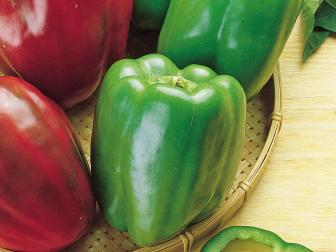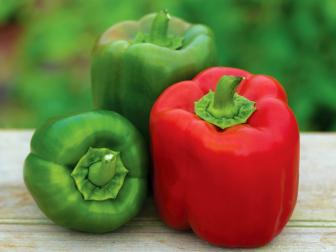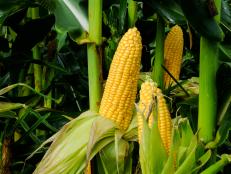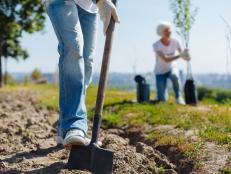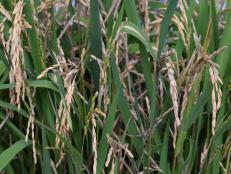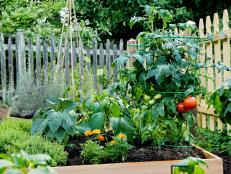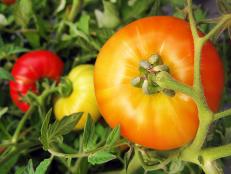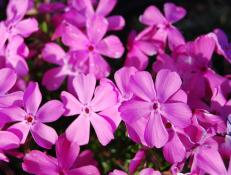Planting and Growing Bell Peppers
Grow delicious bell peppers from seed or seedlings with these expert tips on everything from planting peppers to harvesting.
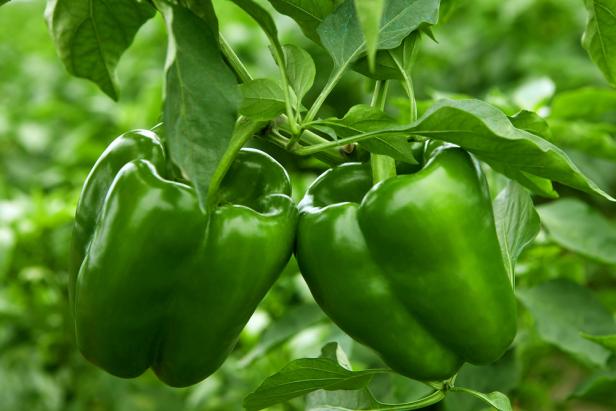
Shutterstock / Volkova

Freshly picked bell peppers add sweetness and a refreshing crunch to summer dishes like kebabs, baked peppers, salads and salsas. With a little planning and extra care, you could pick a peck of your own homegrown sweet bell peppers this season.
Choosing Which Pepper Plants to Grow
Buying nursery-grown pepper seedlings is a simple, instantly gratifying way to add bell peppers to the vegetable garden. Folks who prefer classic varieties like the old standard 'King Arthur' should be able to find what they're looking for from a local garden center.

Image courtesy of JungSeed.com
'King Arthur' produces big, 4- to 5-inch bell peppers. They have a sweet flavor and a crunch that remains whether you pick them green or let them mature to a bright red. They start bearing early, producing fruits in around 60 days, and will continue to bear throughout the summer.
If you're looking for adventure, you should be able to find a wide selection of colors, sizes, shapes and flavors from specialty seed nurseries. The only catch is that you'll need to research important considerations, including how long before your peppers will be ready to harvest, your chosen variety's resistance to common diseases and the type of bell pepper you'd ultimately enjoy eating.
Sweet Pepper Varieties to Grow 17 Photos
These nutritious, rainbow-colored varieties will bring great taste to your table.
You'll also need to start your bell pepper seeds indoors over the winter to ensure seedlings are ready to move outdoors when temperatures rise in the spring.
Days to Maturity
Different kinds of peppers will vary in how long it takes for plants to mature and fruit to develop. Southern gardeners with long, warm summer seasons have the luxury to wait for a specialty crop with a long maturity time. Northern gardeners need to choose varieties that will be able to develop a crop before temperatures dip below 50 degrees in the fall. Your state extension service can help you determine the length of your summer growing season.
Disease Resistance
Unfortunately, peppers are susceptible to some serious and relatively common disease problems. If you've had problems growing peppers in the past and you suspect that a disease may be the culprit, your local extension service can help you identify the cause of any health problems, as well as list common pepper diseases in your area.
What’s Wrong With My Peppers? 14 Photos
Learn about common pepper problems — along with a few tips to make things right.
Shop for varieties that are resistant to health issues like bacterial leaf spot, phytophthora blight, potato virus Y, tobacco etch virus, tobacco mosaic virus and tomato spotted wilt virus. Choose disease-resistant varieties and use good maintenance practices to limit health issues and maximize your harvest.
Types of Peppers
Sweet peppers come in many shapes and colors. Fruits come in the standard hearty bell shape, blocky mini bell peppers, snack-sized "lunchbox" peppers and elongated horns. While all bell peppers start out a tangy green, they develop more color and sweetness as they ripen. Depending on the variety, peppers may mature to canary yellow, fiery orange, crimson red or deep purple.
Getting the Growing Site Ready
Site preparation begins with finding the right spot. Peppers need full sun to grow properly — at least six hours of direct light each day. Soil should be well drained so that roots don't become waterlogged, but also moisture retentive to prevent draining out. If the only spot with enough sunlight also has less-than-ideal soil conditions, you'll need to amend the soil or consider building a raised garden bed or growing bell peppers in pots.
Add Organic Matter
Bell peppers thrive in an environment that is rich in organic matter. Mix a healthy amount of compost, well-aged manure or cover crop residues into the bed before planting. This nutritious organic material will feed beneficial soil organisms as it decomposes, as well as improve water retention, drainage and soil texture in the garden bed.
Do a Soil Test
Like many common vegetable crops, bell peppers will perform better if their nutritional needs are met. The current amount of mineral nutrients in the soil will obviously impact the health of your pepper plants. But also take note of the level of soil acidity or alkalinity (pH). Most nutrients are available to pepper plants in a pH range of 6.5 to 7.0. If the soil is too acidic or too alkaline, plants may have trouble accessing the nutrients in the soil. That's why it's vitally important to perform a soil test before reaching for a bag of fertilizer. Many state extension services offer simple and inexpensive soil testing services that provide a complete report with advice tailored to the crop grown.
Practice Crop Rotation
Bell peppers are in the nightshade family, which includes popular solanaceous crops such as tomatoes, eggplant, potatoes and tomatillos. Plants in this family are usually susceptible to the same pest and disease pressures. Growing the same or related crops in the same spot year after year allows populations of damaging insect pests and disease-causing fungal spores, bacteria and viruses to build up in the soil, primed and ready to feed on this year's veggies. Rotate where you grow nightshades each year to disrupt the cycle and make it harder for pests and diseases to find susceptible crops.
Planting Bell Peppers
When Do Peppers Grow Best?
Timing is everything when it comes to growing sweet bell peppers. These heat-loving veggies were first cultivated in South and Central America. While peppers grow as perennials in their native range and similar tropical climates, in the U.S. we grow peppers as warm-season annuals, moving them outdoors into the summer sunshine once nighttime and soil temperatures are consistently above 50 degrees.
Although it may be tempting to plant peppers outdoors during an odd burst of 80-degree weather early in the spring, it's best to wait until all danger of frosty weather has passed to prevent any chance of cold damage. Check with your state extension service to learn when the average last frost date for your region is. While peppers will tolerate temperatures higher than 50 degrees, they will perform much better in conditions above 75 degrees.
Start Bell Pepper Seeds Indoors for Spring
The length of time between planting a pepper seed and picking a pepper fruit can be surprisingly long. In most areas of the country, starting peppers indoors to get a jump on the growing season just makes sense. Plant pepper seeds eight to 10 weeks before your region's average last frost date. Make sure the potting soil is moist before planting. Scatter the seeds over the soil surface, then lightly cover with more potting mix. Use a seedling heat mat to speed up germination. Place the pot under a grow light or near a bright window. If your pepper sprouts look gangly and stretched out, that means they're not getting enough light.
Once the seedlings develop their first pair of true leaves, they'll be ready to move to their own pots. Young plants of this size shouldn't need a container larger than a standard 4-inch pot. Use a pencil or similar implement to gently lift the plants from the potting soil, being careful not to damage the roots or shoots. Lightly grasp one of the leaves rather than the stem to avoid breaking the shoot. Take care when covering the roots with potting mix, then give the plants a good drink.
Moving Pepper Seedling to the Garden
Begin to "harden off" or acclimate your pepper seedlings to outdoor weather a week or two before planting outdoors. Simply set the pot outdoors in a sunny, sheltered spot on warm days that are above 50 degrees and bring them back inside in the evening. When all chance of frost has passed and evening temperatures are above 50 degrees, your baby peppers will be ready to move outside to the garden.
Of course, you don't have to start peppers from seed. You can find pepper seedlings for sale from your local garden center. Only buy healthy plants, free from any stem lesions, leaf spots or broken branches. Plants should be less than a foot tall with a sturdy, pencil-width stem.
Plant the seedlings at the same level they had been in the pot. Don't bury too deeply or leave the root ball exposed. Varieties can differ in terms of their mature size, so be sure to check the seed packet or plant label for spacing information. Most types of bell peppers can be spaced about 2 feet apart.
Growing Bell Peppers
Water Needs
Consistent water is key for healthy, productive bell pepper plants. Saturate the soil around the base of the stem above the roots every other day for the first week or so while the seedlings adjust to their new environment. Scale back to watering deeply every few days. This will train the roots to seek water deeper in the soil profile, making the plants more resilient during hot summer weather.
Fertilize as Needed
Follow the recommendations from your soil test report (see "Do a Soil Test") to determine the type of fertilizer you should use and the frequency of application. Be especially careful not to overuse nitrogen fertilizer, as that will promote more foliage growth at the expense of flower and fruit development.
Support Plants
Pepper stems can be brittle and may break under the weight of developing fruit. Use a small tomato cage or stake plants to provide extra support. Pinch out the top set of leaves when plants are between 6 and 8 inches tall to promote more lateral branching on shorter, more robust plants.
Spread the Mulch
A thick layer of mulch will suppress weed competition, conserve water, moderate the temperature in the root zone and ultimately feed the soil. However, mulch can also provide habitat to destructive pests like slugs, snails and cutworms that can wipe out a stand of pepper seedlings. Wait until seedlings are several inches tall to spread 3 to 4 inches of a natural mulch, such as composted leaves, bark mulch, pine straw or wheat straw. If you opt for wheat straw, make sure the bales are free of seed, or you'll need to weed wheat seedlings from the garden a few weeks after mulching.
Scout for Health Issues
Keep an eye out for potential pests like cutworms, pepper maggots, pepper weevils and tomato hornworms, or disease problems such as bacterial leaf spot, phytophthora blight, potato virus Y, tobacco etch virus, tobacco mosaic virus and tomato spotted wilt virus. Make room in your garden to experiment with companion planting to attract beneficial pollinators and predators of pests, to limit pest and disease damage and to feed the soil.
Peppers are also susceptible to sunscald — especially in areas where temperatures are consistently above 90 degrees. The leaves or the fruit will develop light colored lesions that have a papery texture. Provide shade from neighboring plants or a tent-like structure to protect plants from intense light.
Blossom end rot is another potential health problem. The main symptom of blossom end rot is the formation of sunken lesions on the fruit, usually near the base. While the cause of this issue is a lack of calcium, calcium deficient soils aren't usually the true issue. Plants absorb calcium along with water. Peppers can develop blossom end rot when irrigation is inconsistent or insufficient, even if there's plenty of calcium in the soil. Symptoms should resolve with better irrigation (or, if necessary, calcium fertilization).
Growing Bell Peppers in Pots
Whether you lack garden space or just prefer container gardening, growing bell peppers in pots is a great idea. Look for pots that are suitably sized (a 1- or 2-gallon pot should do fine) and have plenty of drainage holes in the bottom.
Container-grown peppers will need to be watered more often than peppers growing in the garden, and in the heat of summer, potted peppers may even need to be watered twice a day. Plants growing in unglazed terra cotta may also need to be watered more frequently than other container types because moisture can wick from the sides of the pot.
How to Harvest Peppers
Sweet bell peppers can either be picked green or when fruits are fully colored. Green peppers are usually a little tangier, while colored fruits are sweeter and more developed. Regular harvesting will promote more flower and fruit development — the more fruit you pick, the more fruit you'll get. Always use a sharp pair of hand pruners, snips or scissors to harvest peppers. Attempts to twist or break the fruit from the stem will almost certainly damage the plant.
Speaking of pepper fruits, buzz about male and female bell pepper fruits has been circulating around the internet for quite a while. Rumor has it that fruits that have 3 bumps are male, while bell peppers with 4 bumps are female. This is just not true.
Bell pepper flowers have both male (stamen) and female (pistil) organs. When a bee or other pollinator carries pollen from the stamen to the top of the pistil (stigma), that pollen forms a pollen tube that travels to the ovary at the bottom of the pistil (in the carpel). Once the ovaries are fertilized by the pollen grain, the carpel begins to swell and develop into a bell pepper fruit containing seeds. Botanically speaking, all bell pepper fruit are female in that they develop from the female floral organs.
Sweet peppers taste their best when eaten fresh from the garden. Bell peppers should last about a week or so in the refrigerator, but if they're refrigerated too long, their skin may begin to pucker and sink. Freezing bell peppers is the best way to preserve a bumper crop of peppers that needs to be stored for more than a week.
Stuffed Pepper Recipes from Food Network
Get Food Network's best stuffed pepper recipes — including juicy ragu-stuffed bell peppers and garlicky sausage-filled jalapeños.

.-Battle-on-the-Beach-courtesy-of-HGTV.-.jpg.rend.hgtvcom.196.196.suffix/1714761529029.jpeg)




